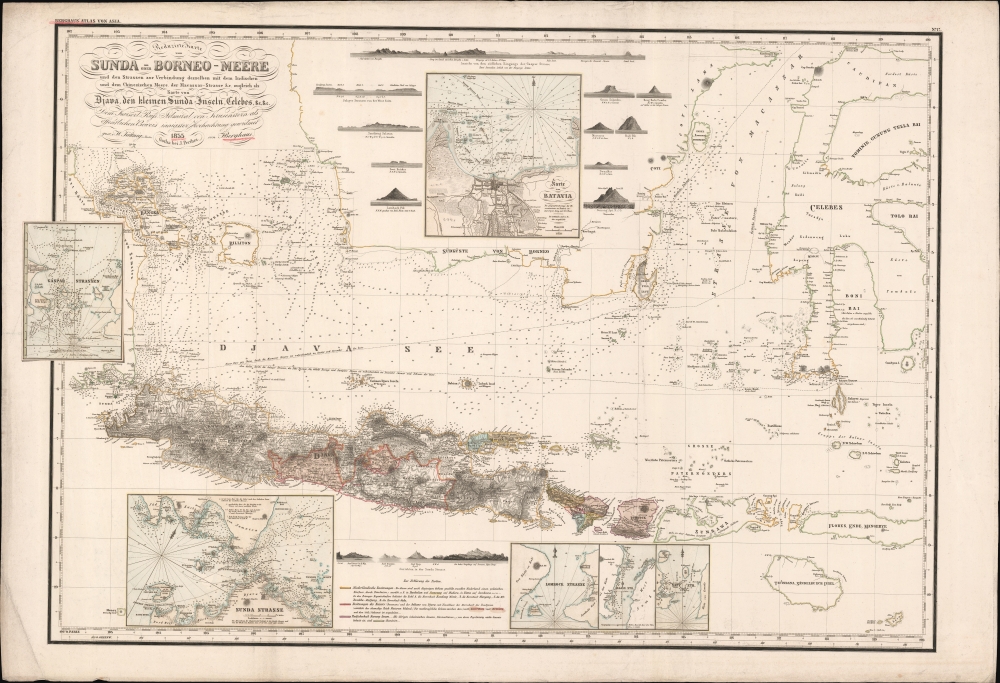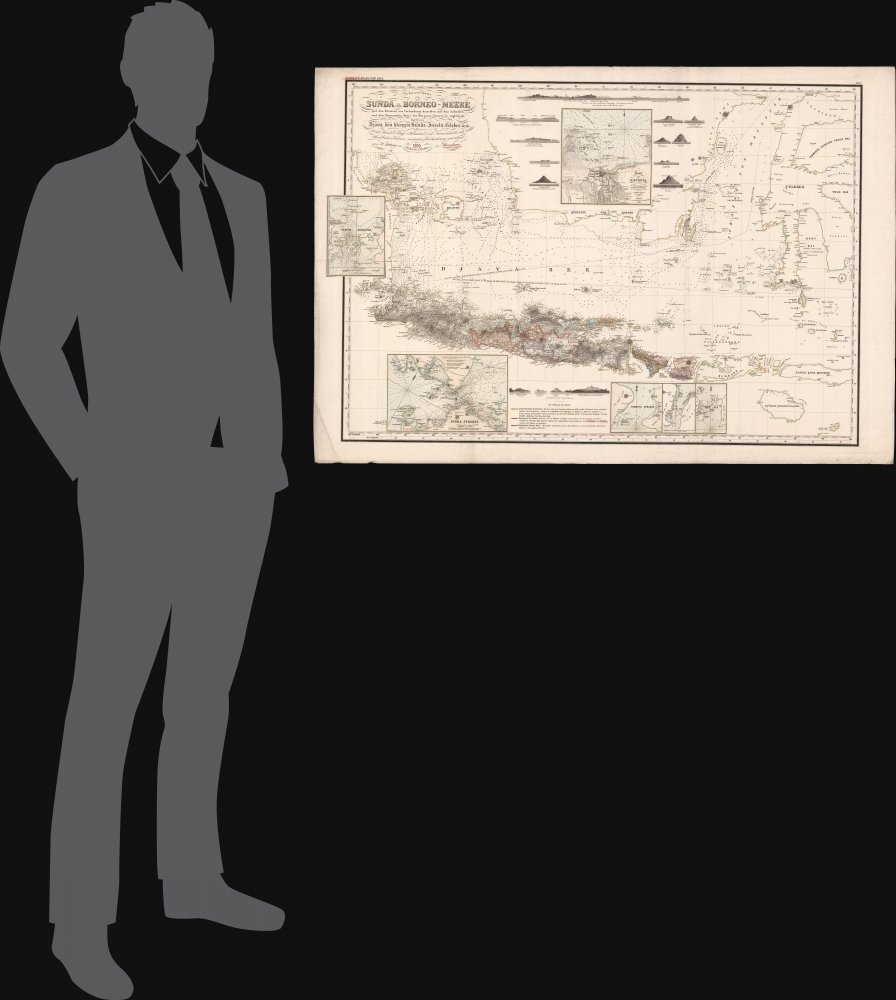1835 Berghaus 'Atlas von Asia' Map of Java and Borneo
SundaBorneo-berghaus-1835
Title
1835 (dated) 26.5 x 39 in (67.31 x 99.06 cm) 1 : 2000000
Description
A Closer Look
Coverage embraces the wide and then little-known region surrounding the Java Sea but focuses most detail on Java, Bali, and Lombok. With land profiles, copious depth soundings, and nautical annotations, it serves well as both a nautical chart and a terrestrial map. The polities in Java, Bali, and Lombok are broken out between Dutch-controlled Java, administered from Batavia, and local Sultanates - particularly south-central Java, which defied Dutch colonial control until 1862.There are six insets, one detailing the VOC administrative center of Batavia (Jakarta), a cluster detailing the Gaspar, Assas, and Sapy Straits. A final large inset details the Sunda Strait, the most critical access point to the Java Sea and points north, making it an essential transit point for the Dutch East India trade. Of note, this inset map prominently includes the island of Krakatoa (Cracatoa), then home to hundreds of villages. Two-thirds of the island was obliterated in an 1883 volcanic eruption, one of the largest in recorded history.
The Dutch East Indies
In the 1830s, the Dutch East Indies comprised most of Java, Sumatra, and the Moluccas. The Dutch government, having dissolved the Dutch East India Company (VOC) by 1799, administered the colony directly with a focus on economic exploitation. Plantation agriculture, including cash crops such as sugar and coffee, was promoted, often with institutionalized forced labor. Infrastructure development, such as roads and ports, facilitated the transportation of goods. Indigenous resistance to Dutch control persisted, leading to local uprisings and conflicts throughout the 1830s, most of which ended with expanded Dutch control. Persistent resistance to Dutch exploitation persisted until the 1940s, when, after a prolonged struggle for independence, Indonesian sovereignty was recognized in 1949.Publication History and Census
This map was published in 1835 by Heinrich Berghaus and Justus Perthes. It was engraved in Berlin by Wilhelm Jätting. The map is no. 17 of Berghaus' Atlas von Asien, all the individual maps of which are exceedingly desirable. We know of examples in the David Rumsey Collection, the Bibliothèque nationale de France, and numerous German collections, but there is little to no presence on the private market.CartographerS
Heinrich Karl Wilhelm Berghaus (May 3, 1797 – February 17, 1884) was a German (Prussian) geographer who founded the Geographische Kunstschule in Potsdam and trained several important German geographers and cartographers of the late 19th century, including August Heinrich Petermann and his nephew Hermann Berghaus. The elder Berghaus also was a friend and associate of Alexander von Humboldt, producing some of the maps in his publications. In 1837, he inherited the Daniel Gottlob Reymann (1759 – 1837) monumental Geographischer Specialatlas von Deutschland. Berghaus is best known for his own influential and wide-ranging atlases, namely Atlas von Asien, published between 1833 and 1837, and Berghaus' Physikalischer Atlas, published in multiple editions in the 1830s - 1840s. Although Atlas von Asien was a commercial failure, it was regarded as a work of supreme quality, boosting the reputation of the publisher Justus Perthes and setting up their next collaboration, Berghaus' Physikalischer Atlas, for success. More by this mapmaker...
Johan Georg Justus Perthes (September 11, 1749 - May 2, 1816) was one of the most important German cartographic engravers of the 19th century. He was born in the Thuringian town of Rudolstadt, the son of a court physician. In 1778, he began working as a bookseller in Gotha. Perthes began his publishing empire shortly thereafter with the 1784 issue of the famed survey of European nobility known as the Almanac de Gotha. In the next year, 1785, he founded the cartographic firm of Justus Perthes Geographische Anstalt Gotha. His son Wilhelm Perthes (1793 - 1853) joined the firm in 1814. Wilhelm had prior publishing experience at the firm of Justus Perthes' nephew, Friedrich Christoph Perthes, who ran a publishing house in Hamburg. After Justus Perthes died in 1816, Wilhelm took charge and laid the groundwork for the firm to become a cartographic publishing titan. From 1817 to 1890. the Perthes firm issued thousands of maps and more than 20 different atlases. Along with the visionary editors Hermann Berghaus (1797 - 1884), Adolph Stieler (1775 - 1836), and Karl Spruner (1803 - 1892), the Perthes firm pioneered the Hand Atlas. When Wilhelm retired, management of the firm passed to his son, Bernhardt Wilhelm Perthes (1821 – 1857). Bernhardt brought on the cartographic geniuses August Heinrich Peterman (1822 - 1878) and Bruno Hassenstein (1839 - 1902). The firm was subsequently passed to a fourth generation in the form of Berhanrd Perthes (1858 – 1919), Bernhard Wilhelm's son. The firm continued in the family until 1953 when, being in East Germany, it was nationalized and run as a state-owned enterprise as VEB Hermann Haack Geographisch-Kartographische Anstalt Gotha. The Justus family, led by Joachim Justus Perthes and his son Wolf-Jürgen Perthes, relocated to Darmstadt where they founded the Justus Perthes Geographische Verlagsanstalt Darmstadt. Learn More...
Wilhelm Jättnig (fl. c. 1830 - 1840) was a German engraver based in Berlin. He is one of the lesser-known scions of Carl Friedrich August Jättnig (1794 – 1849), the youngest son of the engraving dynasty’s founder, Carl Jättnig (1766 – 1819). Wilhelm worked with his father to engrave maps for Daniel Gottlob Reymann’s (1759 – 1837) monumental Geographischer Specialatlas von Deutschland. When Reymann died, the project was passed to Heinrich Karl Wilhelm Berghaus (1797 – 1884). Wilhelm continued to work with Berghaus on the atlas of Germany as well as on Berghaus’ important Atlas von Asien. His uncle, Carl Christian Ferdinand Jättnig (1789 - 1847), and many nephews of the Jättnig name, were also a prominent engravers. Learn More...




